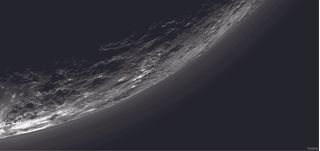Pluto's Hazy Layers Linked to Atmospheric Gravity Waves

Streaks seen in the slightly hazy atmosphere of Pluto may arise because of a phenomenon known as buoyance waves, also known as gravity waves.
While scientists recently made headlines with the discovery of gravitational waves — ripples in space-time created by energetic events such as colliding black holes — gravity waves are something entirely different. The bands in Pluto's atmosphere, first spotted by NASA's New Horizons probe, appear to form much like ripples on the surface of a lake.
"[These are] not cosmological gravity waves, but atmospheric buoyancy waves," said Alan Stern, principle investigator for New Horizons, which made a close flyby of Pluto in July, 2015. "There's now a growing consensus on our team that the structures you see, that horizontal banding or layering, is formed by gravity waves." [Photos of Pluto and Its Moons]
Stern, who is associate vice president of R&D at the Southwest Research Institute (SwRI) in Colorado, spoke about the gravity-wave hypothesis at the Lunar and Planetary Science meeting in The Woodlands, Texas, in March. He said the conclusion that the bands are gravity waves is based on observations made by New Horizons, combined with computer simulations.

Ripples in the atmosphere
Toss a stone into a pond of water. The familiar, spreading ripples are an example of gravity waves, created by a force acting on a fluid. These waves often appear where one fluid meets another (such as the surface of a pond, where water meets air) or where fluids of different densities meet.
The gravity waves on Pluto form in a similar way, Strobel said. On Pluto's surface, materials go through sudden changes — ices transform into gas without first melting into a liquid (in a process known as sublimation), and gases become solid through a process called deposition. These events create forces that push against the atmosphere, Strobel said.
"Any disturbance in the atmosphere can generate gravity waves, such as wind blowing over mountains, [and] evolving weather systems," Darrell Strobel, an atmospheric scientist and a New Horizons team member, told Space.com by email.
Get the Space.com Newsletter
Breaking space news, the latest updates on rocket launches, skywatching events and more!
According to Randy Gladstone, New Horizons Atmospheric Theme Team leader, also of SwRI, Strobel developed the idea that horizontal, sublimation-driven winds flowing over Pluto's mountains could have created the gravity waves that formed the complex atmospheric layers observed by New Horizons. As the waves travel up and down in the atmosphere, they compress and relax regions of haze particles, Gladstone told Space.com by email. Although the waves themselves can't be seen, the resulting in the vertical layering stands out.

"On Pluto, the sublimation of ices and transport of gases to colder regions can force gravity waves," Strobel said.
NASA scientists believe the alternating brightness of the atmospheric layers is also likely due to gravity waves.
Before the New Horizons mission arrived at Pluto in July 2015, the distant world wasn't expected to have much of an atmosphere. While scientists were able to catch glimpses of the gas surrounding the world when it passed in front of a distant star, they could only rely on hints teased from thin data to find out if gravity waves occurred on the planet.
"New Horizons solved this problem in about 15 minutes," Stern said.
The spacecraft observed almost two dozen layers of hazes in the planet's atmosphere, which Strobel's models suggest were formed by gravity waves.
Pluto is far from the only world to host atmospheric gravity waves. They occur on Earth, created by volcanic eruptions or intense heating from the charged aurora. Wind and weather can also generate the waves. Saturn's icy moon Titan and Neptune's moon Triton also have strong signals of gravity waves. Their presence reveals information about the atmosphere of their host worlds, as well as providing hints about surface activity. The waves can also provide hints into the compositions of the atmospheres, as atmospheric makeup affects how large the waves can grow.
"The atmosphere [on Pluto] is not perfectly static; all forces acting on the atmosphere are not in precise balance," Strobel said. "There are pressure differences in the atmosphere, and topographic features that can force winds to generate gravity waves."
Follow Nola Taylor Redd on Twitter @NolaTRedd or Google+. Follow us at @Spacedotcom, Facebook or Google+. Originally published on Space.com.
Join our Space Forums to keep talking space on the latest missions, night sky and more! And if you have a news tip, correction or comment, let us know at: community@space.com.

Nola Taylor Tillman is a contributing writer for Space.com. She loves all things space and astronomy-related, and enjoys the opportunity to learn more. She has a Bachelor’s degree in English and Astrophysics from Agnes Scott college and served as an intern at Sky & Telescope magazine. In her free time, she homeschools her four children. Follow her on Twitter at @NolaTRedd
